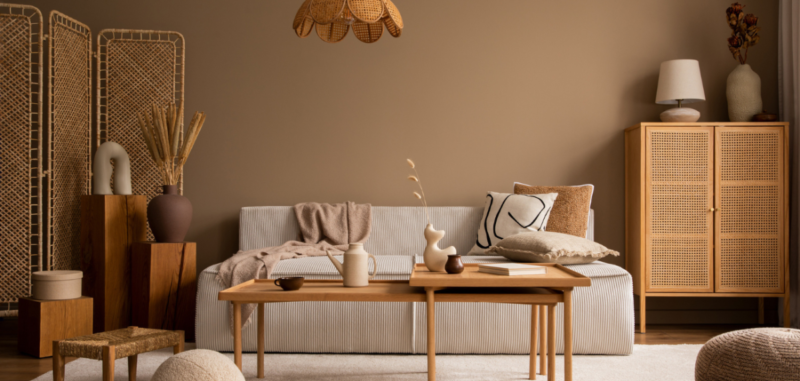From cane frames to woven chair backs, a touch of fast-growing rattan adds warmth to interiors.
Did you know your porch’s wicker furniture and the arched cane bookshelf at your favorite coffee shop might be made from the same material? Warm and natural, rattan has been an interior design mainstay for decades, most notably in the 1970s.
Though rattan looks similar to bamboo, rattan is more pliant, making it a more flexible choice for furniture and framing. Fortunately, rattan is also an eco-friendly material—good news for the many real estate professionals who report more and more clients are interested in sustainability.
Rattan 101
Rattan(link is external) is a type of climbing palm whose flexible stems can be used to make cane furniture. Strands cut into smaller strips can also be used for weaving mats, baskets or flexible coverings.
“[Rattan] is a sustainable material due to its fast-growing nature,” explains Brooke Moore(link is external), an interior designer with California-based presale home renovation company Freemodel. “Unlike other types of wood that can take up to 20 or 30 years to grow, rattan can be fully grown and harvested in only a couple of years.”
Still, sustainability isn’t always straightforward. Rattan, like bamboo, grows in tropical regions. The energy used to transport it from the rainforests of Asia, Africa and Australia impacts the product’s overall sustainability. Clients interested in genuinely sustainable products should work with someone knowledgeable about the material’s origin and production process.
Rattan Trends in Home Design
Rattan looks best in bohemian, mid-century modern, and coastal interior spaces, according to Bilal Rehman(link is external), a Gen-Z interior designer and owner of Bilal Rehman Studio in Houston.
Here’s how Moore and Reman suggest using rattan in your next interior design project.
Rattan headboards
Looking to warm up a home listing during staging? Consider a rattan headboard. The yellow-brown color and ridged texture of rattan weave add visual interest and warmth.
“You can DIY this look by taking a headboard frame and filling in the frame with rattan,” Moore says. “This brings a softer look of wood into a room, which is ideal for a bed that is supposed to feel soft and inviting.”
Rattan-backed chairs
Chairs with rattan weave on the back or seat have been popular for many years. The look of this weave has been recreated and mass-manufactured with less sustainable materials such as resin or vinyl.
“Jeanneret and Cesca chairs are popular mid-century modern chairs designs that are commonly used with rattan material,” says Moore.
Rattan frames
If you haven’t noticed them yet, you’ll soon start to see rattan cane framing mirrors and art at various big-box home decor stores. This is an easy way to incorporate rattan into the living room and bedroom decor.
“I really admired a few mirrors I’ve come across that are framed in rattan rather than metal,” says Rehman. “I found it really interesting to mix the glamor of the mirror with the rougher aesthetic of rattan.”
Stained rattan webbing
While many appreciate rattan’s natural color, the hue is too warm for some settings. No worries, says Rehman. Darkening rattan webbing or wicker can quickly elevate furniture. This is especially useful (and sustainable) when working with vintage rattan pieces.
“The natural color of rattan tends to be a lighter tan-orange hue, so when stained to blend into the surrounding space you’re only left with the textural element of rattan, which can be really stunning,” he says.
Finding Sustainable Rattan Resources and Retailers
Rattan is one of many sustainable design materials. Clients interested in making a home project or renovation more eco-friendly often rely on a mix of sustainable materials, including cork, recycled glass and reclaimed wood.
Both Moore and Rehman say clients seeking quality, sustainable rattan will need to do their research or partner with a professional who does. Rattan can be mimicked by other materials, warns Rehman. Even authentic rattan may be transported or manufactured in a way that undermines its sustainability. To avoid these pitfalls, Moore suggests directing clients toward companies with green accreditations like the Forest Stewardship Council (FSC) certification.
Retailer recommendations from Moore and Rehman:
- West Elm(link is external) for a retail website that allows consumers to narrow searches to sustainable or Fair Trade pieces
- The Rattan Company(link is external) for indoor rattan furniture that is sustainably sourced
- Etsy(link is external) for rattan pieces that support small businesses
- Vintage furniture stores for durable, authentic rattan pieces
- Local furniture-makers for one-of-a-kind rattan pieces that help small businesses
Source: nar.realtor













